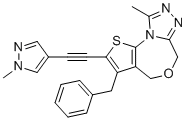
QCA276
CAS No. 2126819-40-5
QCA276 ( QCA 276;QCA-276 )
Catalog No. M13384 CAS No. 2126819-40-5
QCA276 is a novel potent BET proteins inhibitor with IC50/Ki of 10/.3 nM.
Purity : >98% (HPLC)
 COA
COA
 Datasheet
Datasheet
 HNMR
HNMR
 HPLC
HPLC
 MSDS
MSDS
 Handing Instructions
Handing Instructions
| Size | Price / USD | Stock | Quantity |
| 100MG | Get Quote | Get Quote |


|
| 200MG | Get Quote | Get Quote |


|
| 500MG | Get Quote | Get Quote |


|
| 1G | Get Quote | Get Quote |


|
Biological Information
-
Product NameQCA276
-
NoteResearch use only, not for human use.
-
Brief DescriptionQCA276 is a novel potent BET proteins inhibitor with IC50/Ki of 10/.3 nM.
-
DescriptionQCA276 is a novel potent BET proteins inhibitor with IC50/Ki of 10/.3 nM, QCA276 is the BET ligand for PROTAC QCA570; effectively inhibits human BRD2, BRD3, and BRD4 BD1 and BD2 proteins with Ki of 2-20 nM.
-
SynonymsQCA 276;QCA-276
-
PathwayChromatin/Epigenetic
-
TargetBromodomain
-
RecptorBromodomain
-
Research Area——
-
Indication——
Chemical Information
-
CAS Number2126819-40-5
-
Formula Weight401.49
-
Molecular FormulaC22H19N5OS
-
Purity>98% (HPLC)
-
Solubility——
-
SMILESCC1=NN=C2N1C3=C(COC2)C(=C(S3)C#CC4=CN(N=C4)C)CC5=CC=CC=C5
-
Chemical Name3-Benzyl-9-methyl-2-((1-methyl-1H-pyrazol-4-yl)ethynyl)-4H,6Hthieno[2,3-e][1,2,4]triazolo[3,4-c][1,4]oxazepine
Shipping & Storage Information
-
Storage(-20℃)
-
ShippingWith Ice Pack
-
Stability≥ 2 years
Reference
1. Qin C, et al. J Med Chem. 2018 Jul 18. doi: 10.1021/acs.jmedchem.8b00506.
molnova catalog


related products
-
biBET
biBET is a potent, selective, bivalent inhibitor of BET bromodomains.
-
IACS-9571
IACS-9571 is a potent, selective dual TRIM24-BRPF1 bromodomain inhibitor with Kd of 31 and 14 nM, respectively.
-
LP99
LP99 is the first potent and selective BRD7/9 bromodomain inhibitor with Kd of 99 nM for BRD9; inhibits IL‐6 secretion from THP‐1 cells in a dose‐dependent manner.



 Cart
Cart
 sales@molnova.com
sales@molnova.com


